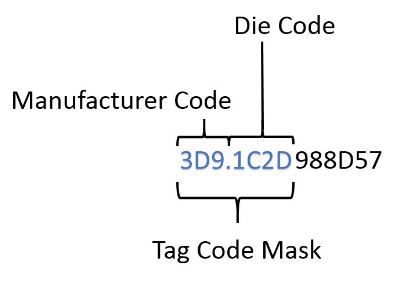|
Tag Masks |
|
 Tag code mask validation is conducted to prevent bad tag codes from misreads or transcription errors being loaded into PTAGIS. It also serves as a way to ensure that we know the source of PIT tags used in the Columbia Basin. The PIT tag infrastructure used in the Columbia Basin is highly specialized and not all tags will perform the same in terms of detection efficiency. It is essential that tags be tested before being introduced into the Columbia Basin to ensure they are compatible with existing infrastructure.
Tag code mask validation is conducted to prevent bad tag codes from misreads or transcription errors being loaded into PTAGIS. It also serves as a way to ensure that we know the source of PIT tags used in the Columbia Basin. The PIT tag infrastructure used in the Columbia Basin is highly specialized and not all tags will perform the same in terms of detection efficiency. It is essential that tags be tested before being introduced into the Columbia Basin to ensure they are compatible with existing infrastructure.
Each tag code received in either MRR or interrogation data is validated against three lists: timer tags, test tags, and tag masks. If a tag is on the timer or test tag list, it is categorized appropriately and automatically screened out of the reporting system, except for reports specifically related to timer tags. If the tag code mask (the Manufacturer Code plus the Die Code) does not match the list of tag masks, it is loaded into the database and categorized as Unknown. All records with unknown PIT tags are automatically screened out of the reporting system, except for one report that relates directly to displaying unknown tags.
If you as a data contributor are purchasing PIT tags outside the BPA Fish & Wildlife program, please read this FAQ about selecting PIT tags. If you do end up purchasing a PIT tag that is new to the Columbia Basin, you will need to request that the tag mask be added as a valid tag mask before submitting data to PTAGIS.
You can view a list of valid tag codes masks on the Validation Codes page.
History
Tag code validation was originally handled directly in the field software programs used for collecting tagging and interrogation data (P3 and Minimon). These programs checked each tag code against a list of known manufacturer codes (the first three characters of a PIT tag code). If the tag did not match, it was not recorded in the program. With the installation of an interrogation site at the Bonneville Dam corner collector in 2006, the size of the antenna and complexity of the transceiver caused spurious tag codes to be generated. To prevent these phantom tags from being loaded into PTAGIS, a special version of Minimon was created that validated tags detected at BCC against a tag mask that included the manufacturer's code and the die code.
In 2012, the validation on tag codes was removed from both P3 and Minimon. Later that year, when interrogation software M4 went into production, validation against the full tag mask was implemented for interrogation data on the server. In August 2014, tag mask validation was implemented on the server for all MRR data.
